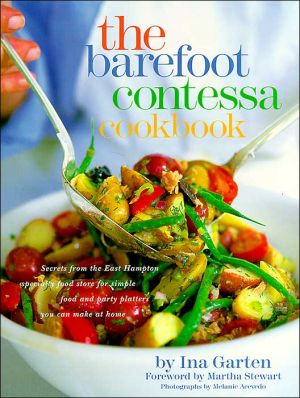Jacques Pépin Celebrates
A fabulous book for people who love to cook. Or for those who want to cook well and are afraid to try.\ To Jacques Pépin, every meal is a celebration. And his delight in creating delicious offerings for family and friends is contagious. Moreover, as he shares here the secrets of the meals he has prepared over the years,\ his careful instruction and his appreciation of ingredients and techniques that make a difference are so persuasive that you want to jump right in and join him at the...
Search in google:
A fabulous book for people who love to cook. Or for those who want to cook well and are afraid to try.To Jacques Pépin, every meal is a celebration. And his delight in creating delicious offerings for family and friends is contagious. Moreover, as he shares here the secrets of the meals he has prepared over the years, his careful instruction and his appreciation of ingredients and techniques that make a difference are so persuasive that you want to jump right in and join him at the stove. Here you’ll find all the dishes that make up the celebratory menus Jacques demonstrates in his new twenty-six-part television series—plus many more. Most of the recipes have been drawn from Jacques Pépin’s The Art of Cooking (now out of print), with many of them updated and refined for today’s home cook.Although the book is organized in chapters from soups to sweets, many main-course recipes are offered with one or two accompaniments that are an integral part of the presentation—and Jacques carefully walks you through the preparations so everything comes out on time. Some are more ambitious, such as a splendid dinner of Chateaubriands with Madeira-Truffle Sauce, Mushroom Timbales, and Crêpe Shells with Corn Puree; others are simple family fare, like Tuna Steaks with Potato-and-Zucchini Salad. All are delicious, representing a range of exquisite and earthy flavors that you can, of course, mix and match at will to create your own menus.Two chapters are devoted to mastering the techniques of making bread and various pastry doughs, and are followed by recipes—both savory and sweet—that utilize these essential culinary skills. Once you’ve learned how to make a crusty baguette, you’ll be confidently whipping up a round of Black Pepper Bread with Walnuts, or Brioche Mousseline, or Cheese Bread. Master the relatively simple pâte à choux and you can make gougères, gnocchi, profiteroles, and a Paris-Brest cake, all with the same basic dough. The same goes for puff pastry, for which Jacques offers three versions: classic, quick, and instant. Embedded throughout the text are Christopher Hirsheimer’s vivid step-by-step photographs of Jacques demonstrating specific essential techniques. With his splendid knifework to guide you, you’ll soon be boning out your own salmon and home-curing it, or creating a beautiful coral tree out of carrots and scallions. Jacques is an artist (his drawings embellish many of these pages), and he inspires you to make your own food visually enticing. Particularly inviting are the chapters devoted to sweet creations, which will bring out the artist in you. Above all, the message here is that cooking is a joy and that your food is a gift to others. So don your apron, fill your kitchen with good smells, and make every occasion a celebration à la Jacques. Publishers Weekly In this companion to a new PBS series, Pepin builds on a broad definition of celebrations encompassing holidays, special occasions, and simply nice weather to present a collection of typically solid French recipes and numerous useful tips and techniques. As on his television series, P?pin's daughter, Claudine, pipes up with the comments of a novice, although these tend to the banal, as when, to accompany recipes for Velvet of Carrot with Browned Almonds and Farmer'sStyle Soup, she gushes, "Soup soup soup! I love making any and all kinds of soup." Recipes for French classics such as Cold Mousse of Chicken and Pistachios and Parsleyed Ham with R?moulade Sauce, and for more untraditional fare like Broiled Lobster Benjamin with Caramelized Corn and Potato Flats and Chateaubriands with Madeira-Truffle Sauce, Mushroom Timbales, and Cr?pe Shells with Corn Puree are complex, but broken down into more manageable components. More valuable than the recipes, however, are the many notes on chopping, garnishing, carving and so forth. Pepin provides step-by-step instructions and often illustrative photographs for everything from how to make a melon swan with a cunning peppercorn eye to how (and why) to rinse chopped onions. (Sept.) Forecast: Pepin is a deservedly successful television host, and his easy manner and impressive skills are well represented here. Although at $40 this is a pricey book, the full-color instructional photos lend much value. This is likely to be a solid seller. Copyright 2001 Cahners Business Information.
introduction\ In our family, we love to celebrate. Anything is an excuse for a celebration, and celebrations always mean food and wine. The holidays, from Christmas to the Fourth of July and Thanksgiving, are usually celebrated at home, as well as the obvious occasions—birthdays, graduations, and anniversaries. A lovely spring day or a cold, crisp day in winter is a pretext for my wife, Gloria, and me to celebrate. Likewise, beautiful artichokes and a plump duck from the market make me want to cook and share the bounty. In our house, life itself is a celebration.\ Any ritual means being together around the table. In our family, the table is the place where all the important events of our life are discussed and resolved, and it is where our family traditions are upheld and sustained. Above all, the table is the place for sharing and pleasure, for, as Brillat-Savarin said, “The pleasures of the table are for every man, of every land, and no matter of what place in history or society; they can be part of all his other pleasures, and they last the longest, to console him when he has outlived the rest.”\ In this book and its companion television series, I am offering recipes that I have prepared over many years and for countless celebrations. Many of the recipes are drawn from the two volumes of The Art of Cooking, which was published in the late 1980s. I have given new life and interpretation to many of these recipes, which are part of our family culinary tradition. With many of the recipes, I have added pictures of the proper techniques required to create these dishes. These often basic procedures and techniques are a very important part of the book and are meant to show certain tours de main, or tricks of the trade, that are difficult to explain in words alone—and isn’t a picture worth a thousand words? Although each of these techniques is presented with a specific recipe to which it applies in the book, it often can an0d should be used in conjunction with other recipes to which it applies. For example, peeling and seeding a tomato, crushing garlic, making a mignonnette, and using a pastry bag are techniques used over and over again in the book. Knowing how to master these procedures will free you from having to look at a recipe over and over again, and that basic knowledge will help you, regardless of which cookbook you choose to cook from. Furthermore, this useful and essential part of the book relates also to the visuals of television, and all the recipes and techniques included in the book are demonstrated on the PBS series Jacques Pépin Celebrates.\ Some recipes, like the Consommé Printanier with Chicken Quenelles, the Caviar with Blini and Frozen Vodka, and the Volcano Surprise with Lemon Mousseline Cake are more elaborate, intended for special parties. Other dishes, such as the Black Bean Soup Augier, the Roasted Turkey with Bread-and-Mushroom Stuffing, and the Rhubarb Galette are inexpensive, simple fare, part of what we eat every day. Meals should be eclectic, diversified, and reflect the occasion, the season, and the mood of the cook.\ In my family, sometimes dinner is quickly prepared, inexpensive, and extremely simple, such as a soup, an omelet, and a tomato salad, or a pizza, a green salad, and some cheeses, and, always, a glass of wine. At other times, the fare is more elaborate and more time-consuming to prepare, often the type of food we enjoy making on the weekend. Such a menu may include the Soufflé of Mussels and Basil, Braised Duck with Glazed Shallots and Honey Sweet Potatoes, a salad, cheeses, and Red Berries–Soaked Cake. In summer, we sometimes eat only from the garden, enjoying a green salad, or a stew of zucchini or eggplant. One type of meal is not necessarily better than another when everything is prepared with care, with love, with fresh ingredients, and with some knowledge of cooking. A simple vegetable soup can be as extraordinary as our Stuffed Salmon in Flaky Dough or Lamb Loins in Ambush with Fava Beans Neyron and Leek-and-Mushroom Pie. What is important is the sharing of food with family and friends.\ Although my basic training was in French cooking, I have not tried in the following recipes to be strictly “French,” or, for that matter, not to be “French.” I have cooked food that satisfies my palate, my stomach, and my soul, food that my family enjoys. Most of the time, my recipes have accents from other cuisines, from Vietnamese and Chinese to American Southern to Tex-Mex. I’ve always been enthralled by the cuisines of Italy and the south of France, and I adore Spanish seasonings, so many of my dishes reflect those particular loves. I invariably try to emphasize the functional aspects of recipes, to simplify dishes and procedures, and to stress the use of fresh and healthful ingredients, and I attempt to explain my recipes in a clear, concise, Cartesian way.\ This cookbook has a larger scope than the other cookbooks and television series I have done. From the Oyster-and-Corn Chowder with Small Cornbreads and the Molded Eggs with Carrot Puree and Truffles to the Broiled Lobster Benjamin with Caramelized Corn and Potato Flats, I have demonstrated dishes that are complex but not difficult to make, dishes that you can prepare successfully at your next party. I have not come close to covering the whole spectrum of cooking, but I have made an attempt to create distinct and diverse recipes, from Venison Steaks with Black Currant Sauce, Chestnut Puree in Zucchini Boats, and Cranberry Relish to Bouillabaisse, and Cassoulet with Pumpkin Seed Sausage to Salmon with Mousseline Sauce. I have created many charcuterie dishes—Home-Smoked Salmon with Cucumber Salad and Salmon Gravlax Evelyn with Onion-and-Cucumber Garnish, Chicken Galantine, Parsleyed Ham with Rémoulade Sauce, as well as Fresh Foie Gras with Port Wine Aspic and a white cheese dish, called Fromage Blanc Jean-Victor with Roasted Garlic and Coral “Tree,” that my father used to make.\ I have recipes for several types of bread, from standard baguettes to Black Pepper Bread with Walnuts, and Brioche Mousseline to Cheese Bread. I have tried to show the versatility of certain mixtures, such as pâte à choux, and to demonstrate how it is used with some of my favorite dishes—Gougères, Parisienne Gnocchi, and Potatoes Dauphine, as well as Profiteroles with Pastry Buttercream and Chocolate Sauce and Paris-Brest Cake with Praline Cream. I’ve done the same thing with puff pastry, giving recipes for three different types of puff paste: a classic version, a fast version, and a practically instant puff paste. I have given extensive examples of uses for this dough in savory as well as sweet dishes, from Puff Pastries of Oysters and Asparagus to a Flaky Raspberry Strip. Great summer fruit desserts are included, as well as a series of soufflés, several chocolate desserts, and petits fours. Because of the complexity of the recipes as well as the special celebrations where these dishes are served, more emphasis is placed on the presentation than would be for everyday cooking; many dishes—cakes and fruit desserts, for example—are served on large, beautiful platters rather than on individual plates. An impressive whole ham with peaches is enticingly carved at the table, and a beautiful, large orange vacherin makes for a stunning presentation.\ My daughter, Claudine, is again my companion and partner in both the book and the television series, and although my wife, Gloria, makes only brief appearances on the shows (she loves her privacy too much), she is very much a part of the soul and spirit of the recipes. After so many years of companionship, our palates crave the same flavors most of the time.\ I want in this book to demonstrate what a great pleasure cooking is for me and my family, how much a part of our lives it is, and how much cooking contributes to the makeup and civilization of the different countries of the world. My hope is that some of my food will add to your family’s enjoyment, relaxation, and pleasure at home, and that, by sharing with you my view of food and wine, I will become, in a small way, a part of your own celebrations and family gatherings.\ Sample recipes:\ FRESH FOIE GRAS WITH port wine aspic yield: 8 to 10 servings\ About 1 1/2 pounds fresh Grade A foie gras\ (1 fattened duck liver)\ seasoning mixture\ 1 1/2 teaspoons salt\ 1/2 teaspoon sugar\ 1/2 teaspoon freshly ground white pepper\ 1/2 teaspoon unflavored gelatin\ 1 1/2 tablespoons good cognac port wine aspic\ 1/2 cup coarsely chopped green of leeks\ 1/2 cup coarsely chopped celery\ 1/4 cup coarsely chopped carrot\ 2 tablespoons loosely packed fresh chervil\ 1 large sprig tarragon\ 1/4 teaspoon freshly ground black pepper\ 1/2 teaspoon salt\ 1 tablespoon unflavored gelatin (about 2 tablespoons)\ 1 egg white from a large egg\ 2 cups good white stock (see White Stock, page 15)\ 1 1/2 tablespoons good port wine\ 1 small truffle, sliced and cut into julienne strips (optional)\ Bread or brioche (see Brioche Mousseline,\ page 288)\ Soak the foie gras, still vacuum-sealed in plastic, in tepid water for about 1 hour to soften.\ Following the illustrations, remove the liver from the plastic. You will notice that it has two lobes. Separate by breaking these lobes apart, and remove and discard as much of the sinews, veins, and gristle running through the liver as possible, pushing inside the meat with your thumb or index finger to dislodge them. (Don’t worry if the liver is broken into several pieces; it will still join together during cooking. However, when the foie gras is to be sliced and sautéed, it is best to slice it before cleaning, then remove the pieces of sinew from the slices afterward.)\ If any part of the foie gras appears greenish, it probably means that the gallbladder has broken and run slightly onto it. This liquid is extremely bitter, and any green areas should be sliced off and discarded. Dry the foie gras with paper towels.\ For the seasoning mixture: Mix the salt, sugar, pepper, and gelatin together in a small bowl, and sprinkle it and the cognac on the foie gras. Push some of the large pieces of foie gras tightly into a glass or porcelain terrine about the same size as the liver (3 inches deep and with a 3-to-4-cup capacity). Arrange smaller pieces of foie gras on top, in the center, and cover with the remaining larger pieces, pressing the liver into a tight block in the terrine.\ Preheat the oven to 225 degrees. Cover the terrine with a piece of plastic wrap and then with aluminum foil, securing it tightly around the edges. Place the terrine in a roasting pan, and add enough tepid water to the pan to reach two-thirds of the way up the outside of the terrine. Bake for about 1 hour, or until the foie gras reaches an internal temperature of about 120 degrees.\ Cut a piece of cardboard to fit on top of the foie gras in the terrine, and wrap the cardboard in aluminum foil. Place the cardboard on top of the foie gras, and add a weight of about 1 pound. Let cool, refrigerated, overnight. The weight will press any extra fat out of the foie gras.\ The following day, remove the weight, and scrape off the surface fat, which can be used to sauté vegetables or added to sauces for flavor. Serve as suggested in the photograph on page 247, or make the aspic as follows. Make sure the foie gras is cleaned of all surface fat and is flat. Press on it with plastic wrap, if need be. Sprinkle the truffle strips on top.\ To make the aspic: Put the leeks, celery, carrot, chervil, tarragon, pepper, salt, and gelatin into a saucepan, then add the egg white, stirring to mix well. Bring the stock to a boil in a separate saucepan, and add it to the aspic mixture, stirring to combine well. Cook over high heat, stirring, until it comes to a strong boil, then stop stirring, remove from the heat, and set aside, undisturbed, for about 15 minutes.\ Strain the aspic through a cloth towel into a saucepan. There should be about 3 cups.\ Let cool to lukewarm, and add the port wine. Cool until aspic is syrupy, then pour a layer about 1?2 inch thick on top of the truffles and foie gras in the terrine. Refrigerate for at least 1 hour before serving.\ SALAD TULIPE WITH WALNUT DRESSING yield: 6 servings This salad is a flavorful combination of field salad, pecans, pears, goat cheese, and walnut-oil dressing. The field or corn salad (doucette or mâche in French) is planted around the end of August and gets large enough to be ready for picking at the end of November. After the first frost, it becomes sweeter and tenderer. If these greens are not available, the salad can be made with a mesclun mixture, widely available now in most supermarkets.\ The pears must be ripe; Bartlett, Comice, or Anjou pears\ 36 to 40 segments field or corn salad (mâche)\ (6 to 8 pieces per person), or 6 cups mesclun salad greens, thoroughly rinsed and dried\ 1 tablespoon unsalted butter\ 30 pecan halves Pinch salt\ 3 ripe pears (Bartlett, Comice, or Anjou)\ 1 tablespoon lemon juice for pears\ 1 teaspoon coarsely cracked black pepper\ (see illustrated mignonnette technique,\ page 30)\ 3/4 pound goat cheese, preferably the small,\ round, semi-hard variety\ walnut dressing\ 1 tablespoon sherry vinegar\ 2 tablespoons walnut oil\ 1/4 teaspoon salt\ 1/4 teaspoon coarsely ground black pepper\ 1 tablespoon peanut or safflower oil\ Preheat the oven to 375 degrees. Try to keep each individual bunch of field salad attached together. Pinch off the bottom of the root from each, and rinse the salad carefully in cold water. Dry in a salad spinner.\ Place the butter on a small baking tray, and heat in the 375-degree oven for about a minute to melt. Scatter the pecans and the salt over the butter, toss together, and bake for 6 to 8 minutes, until nicely browned. Set aside. The pecans should be served at room temperature.\ Halve the three pears lengthwise, then core, peel, and cut each half into three pieces. Sprinkle with lemon juice to prevent discoloration, then sprinkle with the cracked pepper. Cut the goat cheese into small wedges.\ For the dressing: Whisk the vinegar, walnut oil, salt, pepper, and peanut oil in a small bowl.\ Put three pieces of pear near the edge of each plate with wedges of cheese and pecans between. Arrange bunches of field salad in the center of the plates, and sprinkle approximately 2 teaspoons of dressing on each salad. Serve immediately.\ SALMON WITH MOUSSELINE SAUCE yield: 12 to 14 servings\ Salmon is one of the most prized of all fish, and this recipe for a whole salmon makes a rich and impressive main course for a special dinner or a stunning buffet centerpiece. The flesh is most delectable when served warm right out of the poaching broth. Wild salmon, not readily available and quite pricey, is the best, but raised salmon, an Atlantic species, is excellent and available year-round.\ The leeks can be cooked ahead and reheated in hot water at serving time. Salmon caviar or roe, used here as a garnish, is usually available freshly processed, which is better than what you find pasteurized in jars. The salty, slightly acidic taste of salmon eggs contrasts nicely with the richness of the mousseline sauce.\ The mousseline base is a hollandaise sauce, and then whipped cream is spooned on top. The two should not be combined until the last minute, or the sauce will liquefy. The salmon can also be served with herb butter or lemon butter.\ stock for salmon\ 3 quarts water\ 2 teaspoons salt\ 2 medium carrots (about 6 ounces), peeled and cut into 1/2-inch dice (1 1/2 cups)\ 1 1/2 cups sliced celery, preferably the green leafy part\ 2 cups sliced green of leek (from the remains of the leeks in the leeks-and-salmon-caviar recipe, below)\ 4 bay leaves\ 3 sprigs fresh thyme, or 1 teaspoon dried thyme\ 2 teaspoons black peppercorns\ 2 tablespoons white-wine vinegar\ 1 very fresh salmon (about 6 pounds), gutted, with the head on (about 24 inches long and 2 1/2 inches thick at the thickest point)\ leeks and salmon caviar\ 14 to 16 leeks of medium to large size, trimmed\ (see illustrations, page 107)\ 1/2 teaspoon salt\ 3 tablespoons peanut oil\ 1 1/2 tablespoons red-wine vinegar Salt and freshly ground black pepper to taste\ 4 ounces salmon-roe caviar (about 1 slightly heaping teaspoon per person)\ mousseline sauce\ 8 egg yolks from large eggs\ 1 pound unsalted butter\ 1 tablespoon lemon juice\ 1 cup heavy cream garnish About 12 lettuce leaves and 1 bunch parsley, for decoration\ Stock for salmon: Put all the stock ingredients in a large kettle. Bring to a boil, reduce the heat to low, cover, and simmer for 15 minutes. Set the pan aside, off the heat and uncovered, to cool for at least 1 hour.\ Pour the cooled stock (including solids) from the kettle into the bottom of a fish poacher, and arrange the salmon in its wire rack on top. Fill the fish poacher with additional cold water, so the fish is completely submerged. Drape a kitchen towel over the fish to keep it submerged during cooking, and bring the stock to just below the boil, 180 to 190 degrees. (If the stock boils, the fish could twist and break.) Poach a 6-pound salmon at that temperature for 16 to 18 minutes, adding 5 extra minutes for each additional pound. Set the poacher aside, off the heat, and keep the salmon in the hot stock for at least 30 minutes before serving. (If serving the salmon cold, let it remain in the stock until completely cool.)\ Prepare the leeks: Split the trimmed leeks lengthwise into fourths, as illustrated (page 107), stopping just before you reach the root end of each so they remain attached at that end. Wash under cold water, and tie the leeks into two bundles, seven to eight per bundle. Bring 3 quarts of water to a boil, add the salt, and drop the leeks into the water. Cover, bring the water back to a boil, then reduce the heat to medium, and boil gently, covered, for 15 to 20 minutes, until the leeks are tender when pierced with the point of a knife. Drain (reserving the cooking liquid for stock, soup, or sauces, if desired), and squeeze out excess moisture by pressing on the leeks with a spoon. Untie the leeks, then spread them out on a plate, cool them to lukewarm, and split each one lengthwise into pieces. In a small bowl, mix the oil, vinegar, and salt and pepper, and coat the leeks with the dressing.\ For the mousseline sauce: Meanwhile, using the egg yolks, butter, and lemon juice, make a hollandaise sauce (see page 40), and set it aside. In a bowl, whip the cream until firm, then cover and refrigerate.\ At serving time, lift the salmon out of the hot broth, and slide it onto a serving platter. (If you wish, strain and freeze the broth for use in soups or sauces.) Peel off and discard the skin on top of the salmon. Then, using a knife, remove the back fins, which will come off easily from the cooked fish. Scrape off and discard the dark flesh, which is mostly fat, from the top center of the fillet.\ Arrange lettuce and parsley around the salmon. Decorate the salmon with parsley, working quickly so the salmon will still be lukewarm when served.\ At serving time, arrange the equivalent of one leek on each plate, forming the long strips into a round, hollow “nest” for the salmon. To carve the salmon, run a thin, sharp-bladed knife down the middle line of the fish, cutting down to the central bone and separating the top fillet into halves. Then cut the long strips of flesh crosswise into chunks 3 to 4 inches long and, using a fork or spoon to help lift out the cut portions, arrange them in the leek “nests.”\ When the top fillet has been served, lift off the central bone gently, and discard it. Scrape off any skin or fatty tissue from the bottom fillet, then cut it into portions and continue arranging on plates. Sprinkle the salmon roe around the leeks. Transfer the warm hollandaise to a sauceboat, and spoon the whipped cream on top. Mix the cream lightly with the hollandaise as you spoon it out onto the salmon pieces. Serve immediately.\ SALMON IN SORREL SAUCE yield: 6 servings\ Salmon steaks, either with the central bone in or boneless, are always popular, because they are quick to prepare and have an appealingly nutty, mild taste, especially if very fresh and completely clean of skin and sinews. For the following recipe, boneless salmon fillets are cut into steaks about 4 inches long and butterflied. Sorrel, high in oxalic acid, is particularly good with salmon, as the acidity cuts down on the richness and fattiness of the fish. The sorrel leaf, with its stem ends flaring outward, is easily recognizable. If the leaves are large or old, remove their tough, fibrous stems.\ 6 steaks cut from salmon fillets, completely cleaned (each about 4 inches long by 2 inches wide by 1 inch thick, and weighing 4 to 5 ounces)\ 1 tablespoon canola oil cucumber “footballs”\ 1 large seedless English cucumber (about\ 1 pound), peeled\ 1/4teaspoon salt, plus more to taste\ 1 tablespoon unsalted butter for sorrel sauce and salmon cooking\ 11/2cups (loosely packed) sorrel leaves\ 1 tablespoon unsalted butter\ 1 cup heavy cream\ 2 tablespoons water\ 3/4teaspoon salt\ 1/4teaspoon freshly ground black pepper\ To butterfly the salmon steaks: With a sharp knife held flat and parallel to the cutting board, cut through the thickness of each steak, stopping just before you reach the other edge, and open the steak like a book to double its size. Your steaks should be 1⁄2 inch thick and about 4 inches square. Rub the steaks on both sides with the oil, and set them aside.\ For the cucumber “footballs”: Cut the peeled cucumber crosswise into 11/2-inch chunks. (From an English cucumber, you should get six to eight pieces.) Cut each chunk lengthwise into quarters of equal size, then cut out and discard the seed strip in the center, and round off the corners of each piece, making the pieces into little oval football shapes (see illustrated technique for “turning” vegetables, page 268). Bring 1 quart of water to boil in a medium saucepan, and add the 1/4teaspoon salt. Drop in the cucumber pieces, return the water to a boil, and boil the “footballs” for 15 to 20 seconds. Drain. Melt the butter in a skillet, and add the cucumbers. Sprinkle with a dash of extra salt, toss gently, and set aside.\ For the sorrel sauce: Wash and spin-dry the sorrel leaves, then pile them up, one on top of another, and shred them into thin strips, called a julienne or chiffonnade. Heat the tablespoon of butter in a saucepan, preferably stainless steel, add the sorrel, and sauté it gently over medium heat for about 1 minute. You will notice that the sorrel will turn a khaki color. Add the cream and the water to the sorrel, and bring to a boil. Season with 1/2 teaspoon of the salt and the pepper, and set aside.\ When ready to cook the salmon, heat one very large or two medium nonstick skillets over high heat. (No butter is needed.) Sprinkle the six salmon steaks with the remaining 1/4 teaspoon salt, and arrange them in one layer in the hot skillet(s). Cook over medium to high heat for 35 to 40 seconds. Then, using a large spatula, turn the steaks over, and cook them for another 35 to 40 seconds. Set the steaks aside, off the heat, while you prepare the plates.
\ From Barnes & NobleThe Barnes & Noble Review\ Did you hear about that great party last weekend where they served the most amazing food, including a fantastic fruit salad in a melon swan? Oh, right -- it was at your house! I bet you were cooking from Jacques Pépin Celebrates. \ Of all the chefs we see on TV, Pépin has always seemed to me both the most relaxed and the most adept at instructing us on technique. Both qualities are evident in his latest, a companion guide to a new 26-part TV series, as he guides us through 200 festive dishes.\ Pépin encourages us to celebrate occasions large and small -- and celebrations always mean food and wine. There are meals for Hanukkah, Christmas, New Year's Eve, a ski chalet supper, an anniversary dinner, Easter, July 4th, a graduation day buffet, a Valentine's surprise, and a dinner party al fresco. Pépin's daughter, Claudine, provides wine suggestions for the many menus.\ With the spotlight on celebration, Pépin's emphasis is, unsurprisingly, on presentation -- and what presentations! An impressive whole ham with peaches and a mustard peach glaze; a stuffed salmon with its outer coating of flaky dough arranged to mimic the fish, gills and all; a chestnut puree in zucchini boats; "swimming swans" in a raspberry sauce with a caramel cage; and a fruit salad presented in a melon swan.\ As you can tell, most of these are not dishes you whip up after a hard day at work. Though they are complex, they are not necessarily difficult, thanks to Pépin's thorough step-by-step instructions. The payoff is tremendous. And there are plenty of simple menus, too: a picnic of pies, omelets, roast turkey, and so forth, for an everyday, spur-of the-moment party.\ Back to the showy stuff: The pages devoted to illustrated cooking technique are fabulous and show in detail what you need to know. Pépin teaches you how to open an oyster; split a lobster in half; stuff and enclose a salmon in dough; prepare a galantine; make carrot flowers and scallion trees; make caramel cages; pipe meringues; julienne orange skin; and make puff pastry the classic way, the fast way, and the almost instant way.\ Pépin, trained in classical French cooking, uses Spanish, Italian, or Asian flavorings from time to time, but for the most part, the dishes have a French base. All of them are worthy of a place at your next celebration. (Ginger Curwen)\ \ \ \ \ \ Publishers WeeklyIn this companion to a new PBS series, Pepin builds on a broad definition of celebrations encompassing holidays, special occasions, and simply nice weather to present a collection of typically solid French recipes and numerous useful tips and techniques. As on his television series, P?pin's daughter, Claudine, pipes up with the comments of a novice, although these tend to the banal, as when, to accompany recipes for Velvet of Carrot with Browned Almonds and Farmer'sStyle Soup, she gushes, "Soup soup soup! I love making any and all kinds of soup." Recipes for French classics such as Cold Mousse of Chicken and Pistachios and Parsleyed Ham with R?moulade Sauce, and for more untraditional fare like Broiled Lobster Benjamin with Caramelized Corn and Potato Flats and Chateaubriands with Madeira-Truffle Sauce, Mushroom Timbales, and Cr?pe Shells with Corn Puree are complex, but broken down into more manageable components. More valuable than the recipes, however, are the many notes on chopping, garnishing, carving and so forth. Pepin provides step-by-step instructions and often illustrative photographs for everything from how to make a melon swan with a cunning peppercorn eye to how (and why) to rinse chopped onions. (Sept.) Forecast: Pepin is a deservedly successful television host, and his easy manner and impressive skills are well represented here. Although at $40 this is a pricey book, the full-color instructional photos lend much value. This is likely to be a solid seller. Copyright 2001 Cahners Business Information.\ \ \ Library JournalPepin's big new cookbook is the companion volume to his latest PBS series, which features 13 half-hour shows with menus for various occasions (e.g., "Dinner Party al Fresco"), six one-hour specials highlighting different holidays, and seven hour-long theme shows ("Puff Pastry Showcase"). The recipes, however, are more accessibly organized by course. Many of these are drawn from Pepin's earlier two-volume The Art of Cooking (o.p.), and although there are more contemporary dishes here, too, some of them, unfortunately, seem rather dated (deep-fried eggs, cream puff swans, etc.). However, Pepin has always been a wonderful teacher, and this book is filled with innumerable cooking tips and valuable techniques, many of which are illustrated by color photographs (there is a helpful index of these step-by-step photos at the back of the book). An essential purchase for most collections. Copyright 2001 Cahners Business Information.\ \








